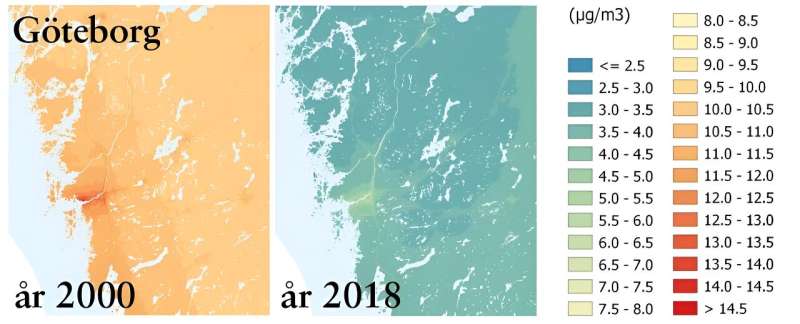This article has been reviewed according to Science X's editorial process and policies. Editors have highlighted the following attributes while ensuring the content's credibility:
fact-checked
trusted source
proofread
Cleaner air in Swedish cities brings significant health benefits: Study

The air quality in Swedish cities has improved continuously over the last 20 years, according to research based at the University of Gothenburg. Several thousand deaths may have been prevented every year, thanks to better air quality. However, many people are still exposed to air pollution that exceeds the World Health Organization's recommendations.
In the study, published in Air Quality, Atmosphere & Health, the researchers present a high-resolution data model of how air pollution levels have changed over time for six cities in Sweden: Stockholm, Gothenburg, Malmö, Linköping, Uppsala, and Umeå. This means that the study covers more than half of the Swedish population.
The researchers have studied emissions of fine particles (PM2.5), coarse particles (PM10), and nitrogen oxides (NOx) from local, regional, and international sources. The studied emissions come from sources including traffic, industry, and wood burning, and have decreased significantly in Sweden since 2000.
The ambient air concentration of fine particles have decreased by a full 56%, coarse particles by 23%, and nitrogen dioxide by 33% from 2000 to 2018. The largest reduction in fine particles was observed in Gothenburg, while coarse particles and nitrogen oxides decreased the most in Uppsala and Stockholm.
Large health gains
"We estimate that almost 3,000 premature deaths were avoided per year between 2000 and 2018 in the six cities modeled in our study," says Karl Kilbo Edlund, a doctoral student at the University of Gothenburg's Sahlgrenska Academy, who is the lead author of the study. "Even more deaths can be avoided through continued work to improve air quality further. Many Swedes are still exposed to air pollution levels that exceed the World Health Organization's 2021 air quality guidelines."
Despite improvements in air quality, 65% of residents in the cities included in the study are still exposed to levels of fine particles that exceed the World Health Organization's guidelines. The study shows that there are significant differences between geographical areas within the six cities, but in general terms the highest exposures are in Malmö.
Pollution moves across long distances, and emissions elsewhere in Europe affect also the air quality in Swedish cities. Falling emissions both in Sweden and abroad therefore explain the improved air quality in Sweden.
The role of pollutants in chronic diseases
The air pollution model will now be used to study the role played by air pollution and other environmental factors in the early stages of chronic diseases, such as cardiovascular disease, metabolic syndrome, and kidney failure. The research is based on data from the large Swedish SCAPIS study, in which 30,000 middle-aged Swedes were surveyed.
In the SCAPIS study, researchers from six universities, including University of Gothenburg, collaborate with air quality experts from the Swedish Meteorological and Hydrological Institute, Stockholm Air and Noise Analysis, and the City of Malmö's Environmental Administration.
More information: Karl Kilbo Edlund et al, High-resolution dispersion modelling of PM2.5, PM10, NOx and NO2 exposure in metropolitan areas in Sweden 2000‒2018 – large health gains due to decreased population exposure, Air Quality, Atmosphere & Health (2024). DOI: 10.1007/s11869-024-01535-0
Provided by University of Gothenburg




















